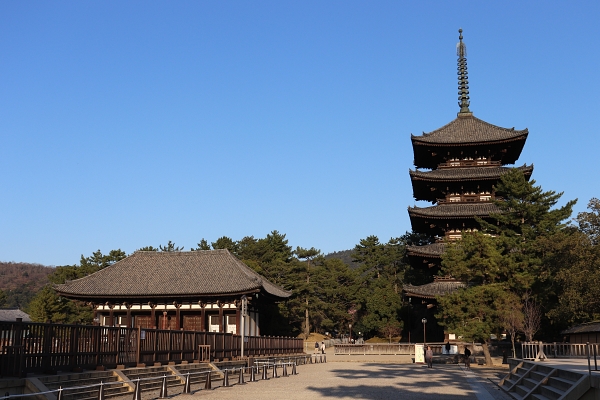Kofuku-ji Temple, Ancient Nara’s Most Powerful Temple
The Daibutsu in Todai-ji, are such big and popular attractions but, there are other attractions in the area that have nothing to do with Todai-ji per se. One example is Kofuku-ji. Once the most powerful temple in Nara, today Kofuku-ji houses many national treasures and Buddha statues. With its roots going back as far as the 7th century, Kokuku-ji is great place to learn about Nara’s ancient history.
Kofuku-ji Temple
Kofuku-ji and Kasuga Shrine
The temples was basically the private temple of the Fujiwara clan, and had strong ties with Kasuga Taisha, which is right next to Kofuku-ji.

In the Heian Period, Kofuku-ji gained so much authority with a number of militarily powerful temples, that they not only took in charge of Kasuga Taisha and became the strongest temple in Nara prefecture. What did they do to get so strong? Whenever there was an political issue they were unhappy with, they would go to the capital in Kyoto, carrying the mikoshi from Kasuga Taisha. There, they would insist that the gods were angry and that the only way to avoid catastrophe was to change said issue or policy.
Temple grounds
Kofuku-ji is located in the middle of the Nara Park, so it is very easy to find.
Once you enter, you will immediately see the five story pagoda, the Gojyu no To. This pagoda is one of the most famous architectural structures in Nara. Empress Komyo ordered construction of the pagoda in 730, but over the years it burnt a number of times. That being said, the current building dates back to 1426, so it’s not exactly new. The Gojyu no To is registered as a Japanese National Treasure.



Unfortunately, another massive fire in the 18th century burnt down the part of the temple, and to make matter worse at the beginning of Meiji era not only did people destroy the temple, but the government confiscated much of the temple grounds. Today, that confiscated land is Nara Park.
Built by Prince Nagaya in 721, the Hokuen-do commemorates the one-year anniversary of the death of Fujiwara no Fuhito. Although the building had to be rebuilt in 1208, its beautiful octagon design attracts many people.

Three story pagoda, or Sanjyu no To, is a bit away from the temple main area, but it is the oldest structure in Kofuku-ji and thus a Japanese National treasure. It was originally built in 1143, and after burnt down, the pagoda was quickly rebuilt in 1180.

To-kondo
Next to Gojyu no To is the To-kondo or the East Kondo. The To-kondo is the main temple building in Kofuku-ji. It enshrines Yakushi Nyorai, and a number of famous statues such as Monjyu Bosatsu, a Japanese National Treasure.


Points of Interest
Nanen-do
In the south of the temple grounds is Nanen-do, which originally built in 9th century. Though it was rebuilt many times, Nanen-do is very popular as it is the 9th of 33 Saigoku Kannon Pilgrimage.

Inside is a Kannon statue of Saigoku Kannon Pirglimage that dates back to the Kamakura Period, but, it can be seen only on October 17th.


Leave a Reply